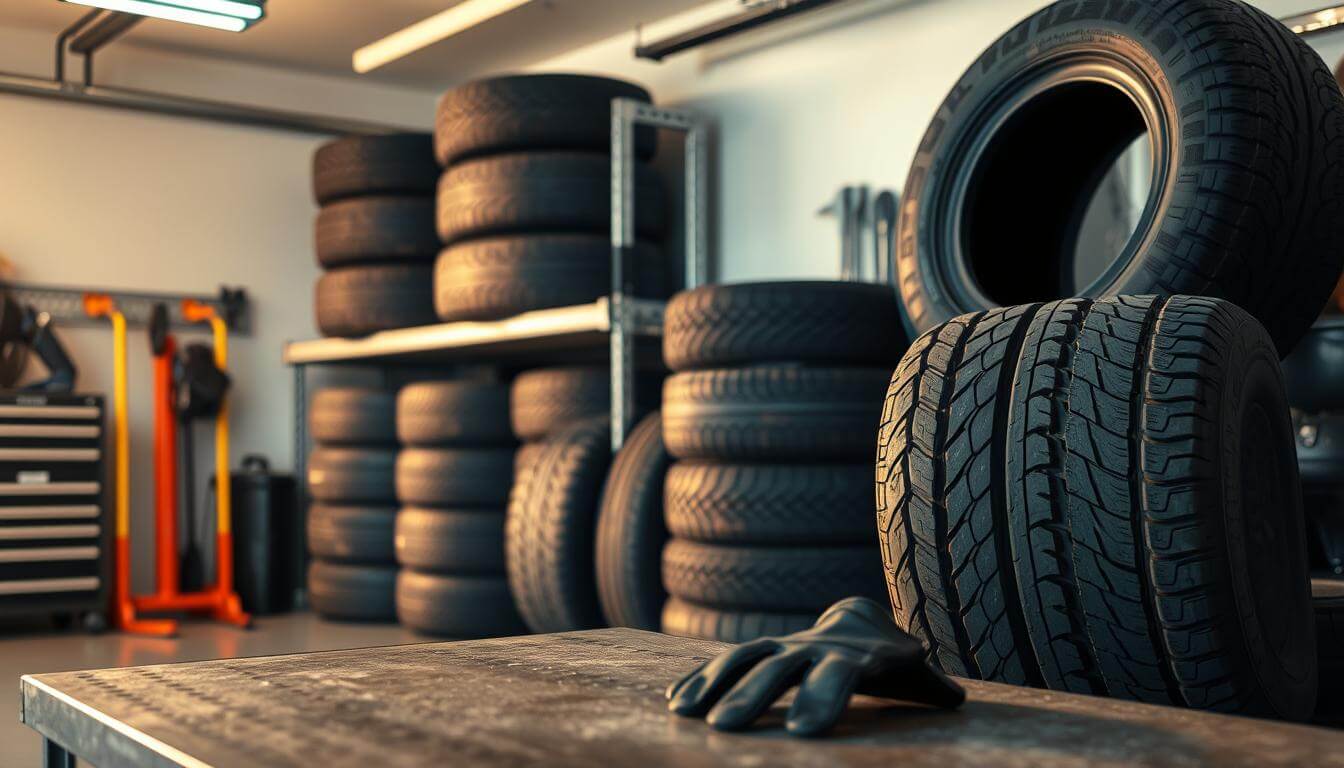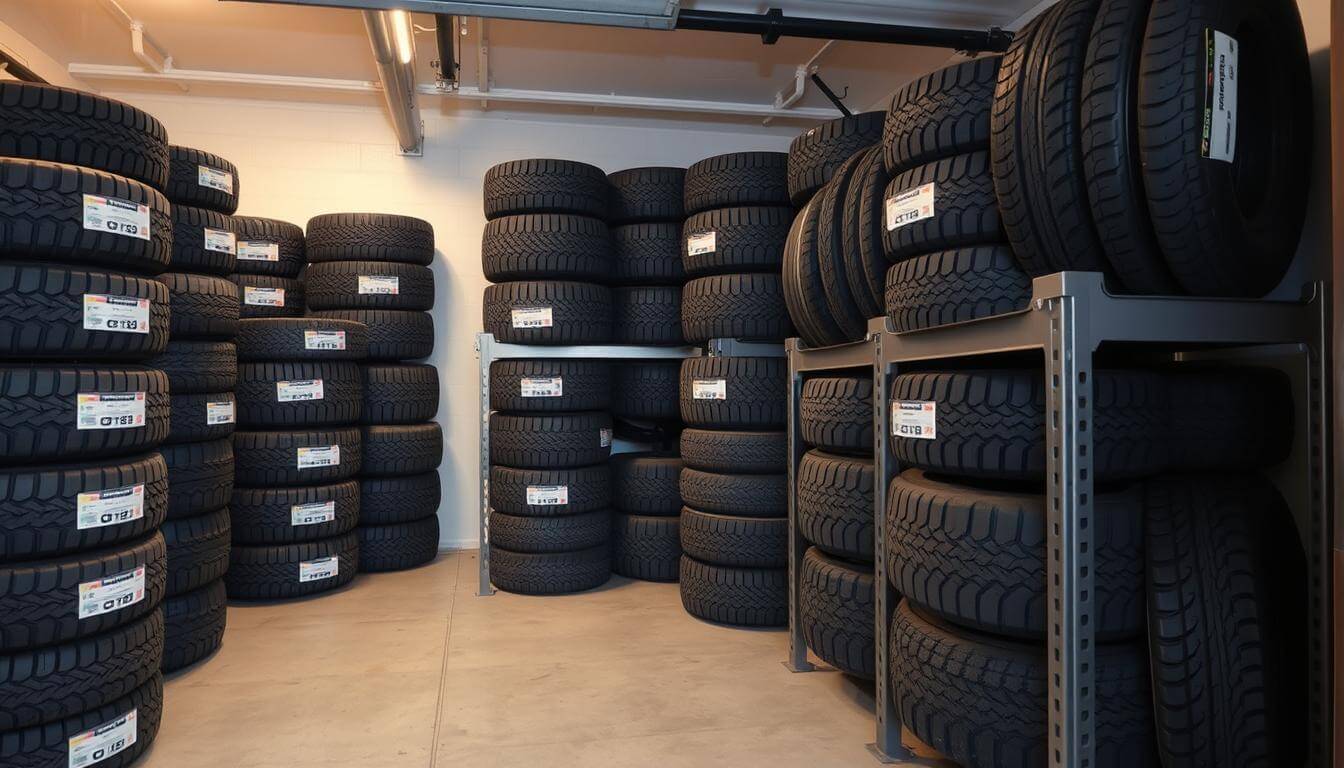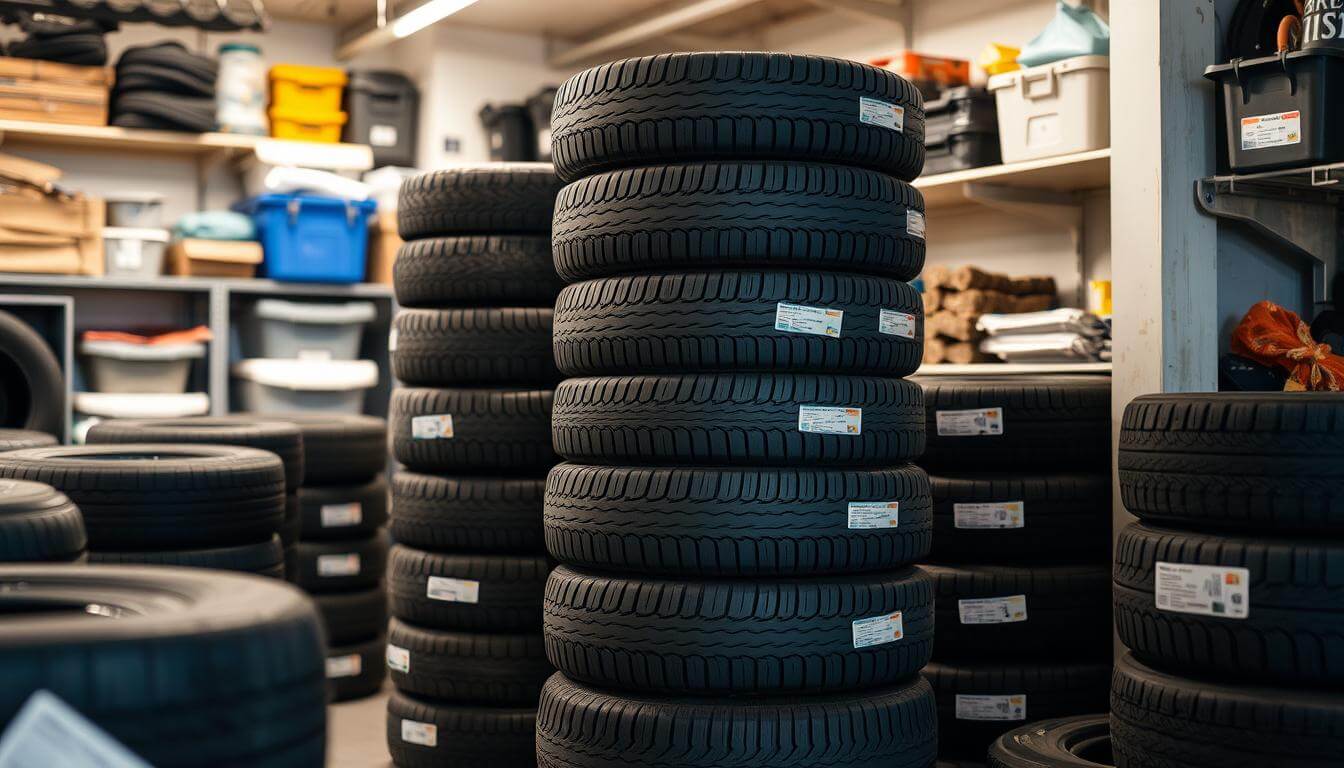As the seasons change, many of us face the challenge of storing our summer tires until the warmer months return. Proper store summer tires is crucial to maintain the performance and longevity. Without the right techniques, your tires could suffer from dry rot or UV damage, which can lead to costly repairs down the line.
Imagine pulling your summer tires out next year, only to find they’ve lost their grip or developed cracks. This scenario is all too common when storage isn’t done correctly. By taking the time to clean, inspect, and prepare your tires, you can extend their lifespan and save money in the long run. Environmental factors like temperature and humidity play a significant role in maintaining the condition of your tires.
Following expert guidelines from reputable sources can make all the difference. These tips will help you enjoy years of reliable performance from your tires. It’s about creating the right environment and taking the necessary precautions to protect your investment.
Key Takeaways
- Proper storage prevents dry rot and UV damage to summer tires.
- Cleaning and inspecting tires before storage extends their lifespan.
- Environmental factors like temperature and humidity affect tire condition.
- Following expert storage guidelines ensures years of effective tire use.
Getting Your Tires Ready for Storage
Preparing your car tires for off-season storage is a crucial step to ensure they remain in great condition. Before you store them, it’s essential to clean and inspect your tires thoroughly.
Clean and Dry Your Tires
Start by removing dirt, brake dust, and road grime using a tire brush and a mild detergent. This cleaning process helps prevent the degradation of the rubber compounds, keeping your tires looking their best and maintaining their integrity. After cleaning, make sure your tires are completely dry. Moisture can cause damage during storage, so drying is a critical step to protect your tires.
Inspect for Damage and Wear
Next, carefully inspect your tires for any signs of cracks, uneven wear, or other damage. This inspection helps you address any issues before storage. Check the tire pressure to ensure it’s at the recommended level for storage. Proper air pressure maintains the tire’s shape and prevents unnecessary strain on the rubber. Additionally, ensure there’s no trapped air that could cause pressure changes during storage.
By following these steps, you’ll help extend the life of your tires and ensure they’re ready for use when the seasons change. Proper preparation now means better performance and safety for your car in the future.
Choosing the Right Storage Environment
When it comes to keeping your tires in top shape during the off-season, the environment where you store them plays a huge role. The right conditions can make a big difference in how well your tires hold up over time.
Temperature and Humidity Control
Maintaining consistent, cool temperatures is key. Aim for a range between 50°F and 70°F to prevent heat damage. Humidity levels should also stay stable to avoid moisture buildup, which can harm the rubber. A damp environment can lead to mold and mildew, so it’s important to keep things dry.
Keeping Tires Away from Sunlight and Chemicals
Direct sunlight is a no-go because UV rays can cause the rubber to degrade. If you’re using a garage, make sure it’s not getting too much sunlight. Also, keep your tires away from chemicals, ozone sources, and any equipment that gives off heat. These can all damage the rubber and shorten the life of your tires.
| Storage Environment | Pros | Cons |
|---|---|---|
| Cool, Dry Basement | Stable temperature and humidity; protects from UV light | Space might be limited |
| Climate-Controlled Unit | Perfect conditions with consistent temperature and humidity | Can be expensive |
| Garage | Convenient and usually dry; easy access | Temperature can fluctuate; possible exposure to chemicals |
| Outdoor Shed | Affordable; extra storage space | Exposure to moisture and temperature changes; risk of pests |
By storing your tires in a cool, dry place away from sunlight and chemicals, you’ll help them last longer and keep them in great shape for when you need them again.
How to Store Summer Tires: Best Practices
When preparing your tires for the off-season, choosing the right storage method is essential to maintain their quality and performance. Whether you decide to stand, stack, or hang your tires, each method has its own set of considerations. Let’s explore these options and find the best fit for your needs.
Compare Storage Methods: Standing, Stacking, and Hanging
- Standing: Standing your tires upright is often recommended as it minimizes stress and deformation. This method allows the weight to be evenly distributed, preventing flat spots and maintaining the tire’s shape.
- Stacking: Stacking is convenient if you have limited space. However, it requires careful placement to avoid putting too much pressure on the tires at the bottom of the stack. Ensure each tire is clean and dry to prevent moisture buildup.
- Hanging: Hanging tires can save space, but it’s crucial to use sturdy hooks and slings. This method is best for mounted tires, as it prevents strain on the sidewalls. Avoid hanging unmounted tires to prevent stretching or damage.
Using Tire Bags and Totes Effectively
Tire bags and totes are excellent for protecting your tires from dust and moisture. Look for airtight options to create a sealed environment. These bags also shield your tires from UV light, which can cause the rubber to degrade over time. When using bags, ensure your tires are completely dry to avoid trapped moisture.
Managing Mounted versus Unmounted Tires
Mounted tires are easier to store because they can be hung or stood upright without additional support. Unmounted tires, on the other hand, are more versatile but require extra care. Standing or stacking unmounted tires is ideal, as hanging can stretch the sidewalls. Regardless of the method, always clean and inspect your tires before storage to ensure they remain in excellent condition.
By choosing the right storage method and using protective gear like tire bags, you can ensure your tires stay in top shape for years to come. Proper storage not only prevents damage but also ensures your tires will perform well when you’re ready to hit the road again.
🚗 Need to Replace Your Summer Tires Before Storage? Amazon Has You Covered!
If your summer tires are worn or damaged, it’s a great time to replace them before putting them into storage. Amazon offers a wide selection of high-quality summer tires for all types of vehicles and driving needs.
✅ Plus, Amazon also helps you schedule professional tire installation services near your location—saving you time and effort!
🔗 Shop Summer Tires on Amazon + Book Local Installation
Additional Long-Term Tire Care Tips
Proper storage and maintenance are key to extending the life of your tires. By following a few simple do’s and don’ts, you can ensure your tires remain in excellent condition for years to come.
Do’s and Don’ts for Proper Tire Storage
| Do’s | Don’ts |
|---|---|
| Keep your tires in a cool, dry environment to prevent weather damage. | Expose tires to direct sunlight, as UV rays can degrade the rubber. |
| Use tire bags or totes to shield from dust and moisture. | Apply chemical treatments that can harm the rubber. |
| Check tire pressure regularly to maintain the recommended level. | Store tires near chemicals or ozone sources. |
By adhering to these guidelines, you’ll protect your tires from environmental stress and ensure your vehicle remains safe and reliable. Proper storage not only preserves your tires but also enhances your driving experience when the seasons change.
☀️ Time to Store or Replace Your Summer Tires? Let Amazon Help!
Whether you’re storing your current set or need new ones, make sure your tires are ready for next season. Amazon offers the best summer tires from top brands, and even makes installation easy with local service partners in your area.
🛠️ Shop smart, drive safe, and enjoy the convenience of having both your tires and installation handled in one place!
🔗 Browse Summer Tires on Amazon + Schedule Local Installation
Conclusion
Properly storing your tires is a smart investment in your vehicle’s future. By following the steps outlined in this guide, you can ensure your tires remain in excellent condition for years to come.
Maintaining the right tire pressure and storing your tires in a cool, dry space are key to preventing damage. Regularly checking the environmental conditions where your tires are kept can make a big difference in their longevity.
Investing a little time now in proper storage can save you from costly replacements and unexpected service issues down the line. Your efforts will pay off when you enjoy consistent performance and safety on the road throughout the year.
Remember, proper tire storage is an essential part of regular vehicle service. Take the proven methods discussed here and put them into action. If you’re ever unsure, don’t hesitate to consult a professional for guidance. Your tires—and your wallet—will thank you!
☀️ Looking for a complete guide on choosing, using, and maintaining summer tires? Don’t miss our in-depth resource that covers everything you need to know about summer tires:
👉 Everything You Need to Know About Summer Tires: A Powerful & Reliable Summer Tires Guide in 2025
FAQ
1. How do I prepare my summer tires for storage?
Before storage, clean your tires thoroughly with mild soap and water to remove grime and brake dust. Let them dry completely to prevent precipitation and humidity from affecting the tire compounds. Inspect the tires for cracks, uneven tire wear, or sidewall damage to avoid issues after a long period of inactivity.
2. What’s the best environment for summer tire storage?
Always choose a climate-controlled space or indoor garage with stable ambient temperatures. Exposure to cold temperatures, electric motors, and fluctuation in humidity can deteriorate black rubber compounds. Storing tires indoors helps preserve their shape and prevent tire degradation.
3. Can I store summer tires outside during the winter?
Storing summer tires outside is not recommended, especially in cold temperatures below 5°C or 7°C, as the rubber compounds may harden and discoloration or premature aging can occur. If outdoor storage is the only option, use airtight plastic bags or leaf bags, and remove as much air as possible to protect against exposure to the elements.
4. What is the best way to store summer tires on rims?
If your tires are mounted on rims, you can stack them horizontally or hang them. Place them on a clean surface to distribute weight evenly and avoid flat tire spots. For longer periods, consider using a tire rack to reduce the stress from the weight of the vehicle.
5. Can summer tires be stored unmounted?
Yes, unmounted summer tires are best stored upright (vertically) to prevent flat spots and deformation. Rotate their position slightly every few months to prolong lifespan and prevent tire wear.
6. How do I check tire condition before storage?
Inspect the tires for cracks, vibration-causing damage, punctures, and overall tread wear. If you notice irregular wear patterns, wheel alignment or tire rotation may be needed before reinstalling. If in doubt, consult a tire professional or consider tire repair options.
7. Should I use tire bags or covers?
Yes, use airtight plastic bags or breathable tire storage covers to shield your tires from sunlight, ozone, and moisture. This is especially important when tires are stored for extended periods of time. For added protection, remove as much air as possible from the bag.
8. Does tire inflation matter during storage?
If your tires are mounted, check tire pressure before storage and maintain recommended inflation levels to prevent tire deformation and cause vibrations later when driving. For unmounted tires, inflation is not required, but structural integrity still matters.
9. How often should I inspect stored summer tires?
Inspect your stored tires every few months. Check for changes in shape, pressure (if mounted), or signs of aging. Long-term tire maintenance and monitoring ensure the tires don’t deteriorate before reuse.
10. Can prolonged storage impact tire performance?
Yes, inactivity and poor storage can affect traction, increase vibrations while driving, and shorten tire life. To maintain good performance, follow correct storage practices, rotate the tires, and have them checked before reuse.



